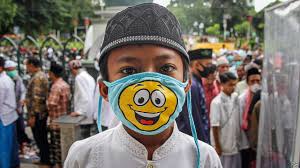Should people wear masks in public to slow the spread of SARS-COV-2?
人们应该在公共场合戴口罩来减缓SARS-COV-2的传播吗?
The World Health Organisation (WHO) says don't bother. The British government agrees.
世界卫生组织(WHO)说不用这么麻烦。英国政府表示同意。
America's Centres for Disease Control and Prevention (CDC) initially discouraged it but by the beginning of April had reversed course.
美国疾病控制与预防中心(CDC)起初不鼓励,但到4月初,情况发生了逆转。
In parts of Asia, including China, it is baked into public behaviour and encouraged by health agencies,
在包括中国在内的亚洲部分地区,即使没有持续的公共卫生危机,
even when there is no ongoing public health crisis. The issue?
戴口罩也被纳入公共行为并受到卫生机构的鼓励。问题呢?
Whether or not members of the public should wear face-masks in a bid to slow the spread of SARS-COV-2, the virus responsible for the covid-19 pandemic.
公众是否应该戴上口罩,以减缓SARS-COV-2的传播。SARS-COV-2是造成covid-19全球流感大流行的病毒。
Understanding all the ways that SARS-COV-2 is transmitted is a matter of active scientific discussion.
理解SARS-COV-2的所有传播途径是一个积极的科学讨论问题。
In the main, though, the virus hitches a ride on droplets of mucus or saliva that come out of the respiratory tracts of infected individuals.
不过,在大多数情况下,这种病毒只是附着在从感染者呼吸道流出的粘液或唾液飞沫上。
These may be expelled during normal breathing or, more commonly, as a cough that propels them a few metres into the air.
它们可能在正常呼吸时被排出体外,或者更常见的是,通过咳嗽将它们推向几米高的空中。
Thus propelled, they may reach another person's eyes, mouth or nose directly, and go on to infect cells in that individual's airways.
因此,被弹出后,它们可能直接到达另一个人的眼睛、嘴巴或鼻子,然后继续感染那个人呼吸道的细胞。
Or they may land on a surface, on which the virus particles they contain could survive for hours, or even days,
或者它们会落在一个表面,表面上的病毒颗粒可以存活几个小时,甚至几天,
and from which those particles may eventually be transferred to others who touch the surface and then touch their own face or mouth.
并且这些颗粒最终可能会转移给那些触碰了这个表面,然后再触碰到自己的面部和嘴部的人体内。

There is no doubt that masks form a barrier to transmission, by stopping droplets passing from infected to uninfected people close by.
毫无疑问,口罩通过阻止飞沫从附近的感染者传播到未感染者,并通过这种方式形成了一个传播障碍。
The WHO recommends standard surgical masks as part of the personal protective equipment
WHO建议将标准医用口罩做为个人防护设备的一部分,
to be worn by doctors and nurses who are caring for covid-19 patients in clinics and hospitals. The same goes for anyone caring for a patient at home.
让在诊所和医院照顾covid-19病患的医生和护士佩戴。同理适用于任何在家照顾病人的人。
In most instances this is good enough, according to a meta-analysis of four randomised controlled trials
根据加拿大麦克马斯特大学的Mark Loeb本月在《流感》期刊上发表的
that was published this month in Influenza by Mark Loeb of McMaster University, in Canada.
对四项随机对照试验的荟萃分析结果来看,在多数情况下,这样做就足够了。
Indeed, Dr Loeb found no significant differences between surgical masks and their more sophisticated cousins, N95 respirators,
Loeb博士发现,在保护医护人员免受飞沫传播的病毒感染(包括包括由冠状病毒引起的感染)方面,
when it came to protecting healthcare workers from viral infections transmitted by droplets—including those caused by coronaviruses.
医用口罩和更加精制的N95口罩没有明显区别。
This suggests that N95 respirators (which are thicker, more rigid, and designed to form a close seal around the nose and mouth) should be reserved for riskier situations.
这表明N95口罩(更厚、更硬,能在鼻子和嘴巴周围形成紧密的密封)应该预留给风险更大的情况。
"N95" means they block at least 95% of particles smaller than 0.3 microns across.
N95意味着它们至少能阻挡95%直径小于0.3微米的粒子。
They are, therefore, appropriate for situations when the threat comes from objects smaller than exhaled droplets— meaning less than about five microns across.
因此,它们适用于当威胁来自比呼出的飞沫还小的物体时,也就是直径小于5微米的物体时的情况。
These particularly include times when doctors and nurses need to "intubate" a patient in an intensive care unit,
这些情况包括当医生和护士需要在重症监护病房给病人“插管”的时候,
by inserting the tube of a ventilator deep into that patient's trachea. Intubation is a forceful procedure, and it creates aerosol particles
即将呼吸机的管子深深插入病人的气管中。插管是一种强制性的过程,在此过程中会产生气溶胶颗粒
(ie, smaller than five microns) that may carry viruses much farther through the air than droplets can manage.
(如小于5微米),这些颗粒携带病毒在空气中传播的距离可能远远超过飞沫所能达到的距离。
Though it remains unclear whether SARS-COV-2 is transmitted via aerosols in this way,
虽然目前还不清楚SARS-COV-2是否以这种方式通过气溶胶传播,
those performing intubations should be cautious, says Lisa Brosseau, a respiratory protection and infectious-diseases scientist at the University of Illinois at Chicago.
但那些给病人插管的医护应该谨慎,芝加哥伊利诺伊大学的呼吸道防护和传染病科学家Lisa Brosseau说到。
译文由可可原创,仅供学习交流使用,未经许可请勿转载。



